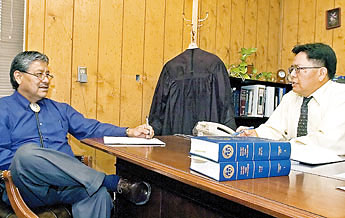|
Harmony, not punishment
Traditional practices wanted in courts

Window Rock District Court judges, Allen Sloan, left, and T.J. Holgate
discuss the Navajo Nation Law on Thursday afternoon inside Holgate's
Chambers in Window Rock. Judge Holgate and Sloan would like to move
away from the non-Navajo system and revert to Navajo Nation tradition
of dispute, resolution and process. [Photo by Matt Hinshaw/Independent]
By Natasha Kaye Johnson
Diné Bureau
WINDOW ROCK — Judge Allen Sloan has never felt comfortable
wearing a judge's robe. Nor has he ever gotten used to people rising
as he enters the courtroom in his 18 years as being a Navajo Nation
judge.
"I've always felt uneasy about it," Sloan said Tuesday
afternoon.
While the two practices are customary in Western court systems,
Sloan said, they don't reflect traditional Navajo traditional practices,
which the Navajo Court system is based upon.
These are some of the thoughts that Sloan often contemplates in
the quiet of his chambers, and shared Tuesday afternoon as the Nation
celebrated Justice Day. This week, Window Rock District Court was
among several district courts across the Nation that observed the
Navajo people's ability to practice their laws in a courtroom setting.
On April 1, 1959, the Navajo Nation courts were implemented, taking
the place of the Bureau of Indian Affairs Code of Federal Courts
that were then in existence. Navajo judges no longer had to make
decisions based on state and federal procedures that centered around
punishment, but instead were able to apply laws were based on the
idea of regaining harmony.
The leaders during that time envisioned a court system that mirrored
teachings of the Holy People, and today that vision continues to
be carried out by Navajo Nation judges.
"Traditional law is based upon the concept of common sense,"
said Window Rock District Judge T.J. Holgate.
In 1985, the Judicial Reform Act was revised by the Navajo Nation
council to give more flexibility to promote common law in the courts.
While western court systems put a primary focus on procedure, Navajo
courts put more emphasis on examining the problem, and seeking a
solution, Holgate said.
"In Biligaana court," said Holgate, "People present,
'This is why I should win,' or say, 'This is why we lost.' "
"The Navajo law goes a little deeper," he said. "Its
based on K'e (family)."
Unlike Western court, where people are taught not to give away information,
or show weakness, Navajo court encourages people to communicate
their problems, and come to mediation.
"We want to use our own traditional values to solve our problems,"
said Sloan. "The focus of law has now been a community focus."
While traditional law was understood by many judges, applying it
was another thing, especially since many of Nation's judges were
taught to pay close attention to technicalities and precise procedure.
"Navajo judges have always had that dilemma," said Sloan.
"We're taught in non-Navajo settings."
Sloan said he finds it refreshing that the courts have found a re-surgence.
If you allow families to be part of the court proceedings, he said,
the possibility of a case coming back is very rare.
Educating people
While the implementation of Navajo law in the judicial system is
celebrated among a majority of Navajo people, there are some people
who have not fully embraced it.
"The change has been approached with mixed feelings,"
said Holgate.
"While there's some resistance, it's not so much because of
anti-traditional or anti-Navajo resistance; it's because of the
unfamiliarity of the system," said Sloan.
Because some people are not raised in a traditional setting, judges
must often explain the purpose of the court.
"It's incumbent of the judge to explain the process,"
he said. "The more people become familiar with it, the more
effective it becomes."
Sloan would like to see the courts officially replace the black
robe with perhaps a piece of jewelry, just as leaders wore traditionally
when they mediated problems among the community.
"We do it purely out of practice," he said, of wearing
the robe.
Reflecting a more traditional setting, he also believes it would
be more appropriate to have the judge enter the court room chambers
before the people, just as a medicine man would enter a hogan before
the people when about to conduct a traditional ceremony.
"Court proceedings are reverse of traditional ceremonies,"
he said. "The way we use the non-Navajo process to instill
non-Navajo thinking must stop."
|
Friday
April 6, 2007
Selected
Stories:
Bringin' in
the bacon; County officials praise Rainaldi's efforts
Harmony,
not punishment; Traditional practices wanted in courts
Grants'
public art, galleries celebrate the area, culture
Broken
water line disrupts RMCH
Death
|



